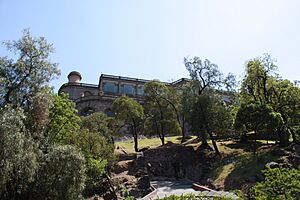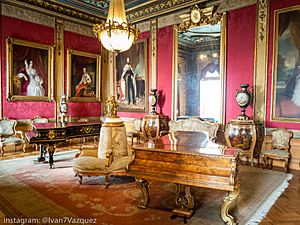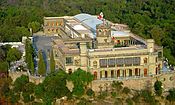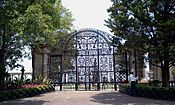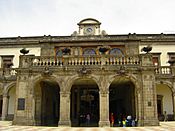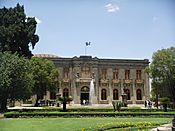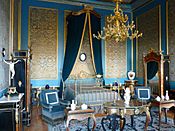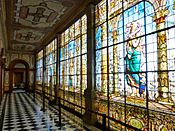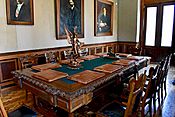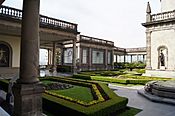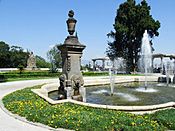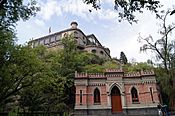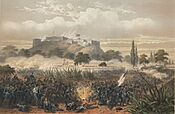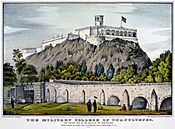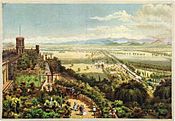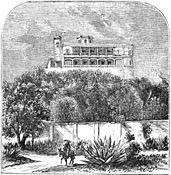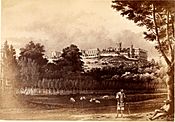Chapultepec Castle facts for kids
Quick facts for kids Chapultepec Castle |
|
|---|---|
|
Castillo de Chapultepec
|
|
| General information | |
| Architectural style | Neo-romanticism, Neoclassical, Neo-Gothic |
| Location | Miguel Hidalgo, Mexico City, Mexico |
| Elevation | 2,325 metres (7,628 ft) above sea level |
| Current tenants | Museo Nacional de Historia |
| Construction started | c. 1785 |
| Completed | 1864 |
| Height | 220 feet (67 m) |
| Design and construction | |
| Architect | Eleuterio Méndez, Ramón Rodríguez Arangoiti, Julius Hofmann, Carl Gangolf Kayser, Carlos Schaffer |
| Other designers | Maximilian I of Mexico |
| Official name: Part of the Historic center of Mexico City | |
| Type: | Cultural |
| Criteria: | i, ii, iii, iv, v |
| Designated: | 1987 (11th session) |
| Reference #: | 412 |
| Region: | Latin America and the Caribbean |
Chapultepec Castle (Spanish: Castillo de Chapultepec) sits on top of Chapultepec Hill in Mexico City. The name Chapultepec comes from the Nahuatl language, meaning "on the hill of the grasshopper." This historic castle is located at the entrance to Chapultepec park, about 2,325 meters (7,628 feet) above sea level.
For the ancient Aztecs, this hill was a sacred place. Over time, the buildings on it have been used for many different things. It was a military academy, a home for emperors and presidents, and even an observatory. Since February 1939, it has been the National Museum of History. Chapultepec Castle is one of only two royal palaces in North America where monarchs actually lived. The other is Iturbide Palace, also in Mexico City.
The castle was first built during the time of New Spain, when Spain ruled Mexico. It was meant to be a summer home for the highest Spanish official, called the viceroy. Later, it was used as a place to store gunpowder and then became a military academy in 1841. It was greatly changed and became the official home of Emperor Maximilian I of Mexico and his wife, Empress Carlota, during the Second Mexican Empire (1864–1867).
In 1882, President Manuel González announced that the castle would be the official home for the president. Most presidents lived there until 1934. That's when President Lázaro Cárdenas chose to live at Los Pinos instead. He then turned the castle into the museum it is today in 1939.
Contents
Building the Castle: The Viceregal Period
In 1785, Viceroy Bernardo de Gálvez decided to build a grand house for himself. He chose the highest point of Chapultepec Hill. Francisco Bambitelli, a Spanish Army engineer, drew the plans. Construction started on August 16 of that year.
When Bambitelli left for Havana, Captain Manuel Agustín Mascaró took over. The work went very quickly under his leadership. Some people accused Mascaró of building a fortress to rebel against Spain. Viceroy de Gálvez died suddenly in November 1786, which led to rumors that he was poisoned. However, there has never been any proof of this.
After the viceroy's death, there was no main engineer. The Spanish Crown decided to sell the building. They offered it for a very low price, but no one bought it. Viceroy Juan Vicente de Güemes Pacheco de Padilla y Horcasitas then thought about making it a national archive. This idea also didn't happen.
In 1803, German scientist Alexander von Humboldt visited the site. He was upset that the palace's windows were sold to raise money for the Spanish Crown. Finally, in 1806, the local government of Mexico City bought the building.
The Castle During Mexico's Independence
Chapultepec Castle was left empty during the Mexican War of Independence (1810–1821). It stayed empty for many years until 1833. In that year, a law was passed to make the building the home of the Military College. This was a school for training army cadets.
To make it suitable for the college, several changes were made. One important addition was the watchtower, known as Caballero Alto ("Tall Knight").
During the Battle of Chapultepec in 1847, Mexican soldiers bravely defended the castle. They chose to fight rather than surrender to American forces. On September 13, 1847, the Niños Héroes ("Boy Heroes") died defending the castle. This happened when United States forces took the castle during the Mexican–American War. A large mural on the ceiling above the castle's main entrance honors these young heroes.
The United States Marine Corps remembers its part in the Battle of Chapultepec. The first line of their song, the "Marines' Hymn," says "From the Halls of Montezuma." Marine Corps tradition says that the red stripe on the trousers of officers and non-commissioned officers, called the blood stripe, honors the many Marines who died storming the castle. It's important to know that the "Halls of Montezuma" part is not historically accurate. The castle was built by Spanish rulers, more than 300 years after the Aztec Emperor Montezuma was overthrown.
Later, President Miguel Miramón, who had also studied at the Military Academy, added several new rooms to the second floor of the palace.
The Castle as an Imperial Home

When Mexican conservatives invited Maximilian von Hapsburg to become emperor, the castle became his home. It was then known as Castillo de Miravalle. Maximilian and his wife, Empress Carlota, moved in during 1864.
The Emperor hired several architects from Europe and Mexico to update the building. These included Julius Hofmann, Carl Gangolf Kayser, Carlos Schaffer, Eleuterio Méndez, and Ramón Cruz Arango. They designed many changes in a neoclassical style. This made the palace a more comfortable royal residence. European architects Kayser and Hofmann also worked on other castles, like Neuschwanstein Castle in Germany.
A botanist named Wilhelm Knechtel was in charge of creating a beautiful roof garden on the building. The Emperor also brought many pieces of furniture, art, and other fine household items from Europe. Many of these items are still on display today.
At that time, the castle was outside Mexico City. So, Maximilian ordered the building of a straight boulevard. This road was designed like the grand boulevards in Europe, such as Vienna's Ringstrasse or Paris's Champs-Élysées. It connected the castle to the city center. He named it Paseo de la Emperatriz ("Promenade of the Empress") to honor his wife.
After the Republic was restored in 1867 by President Benito Juárez, the boulevard was renamed Paseo de la Reforma. This name honored the Liberal reform movement.
From Presidential Home to Museum
The castle was not used much after the Second Mexican Empire ended in 1867. In 1876, a law made it an Astronomical, Meteorological, and Magnetic Observatory. This observatory opened in 1878 during the presidency of Sebastián Lerdo de Tejada. However, it only operated for five years. It was then moved to allow the Military College to return. The building was also planned to become the presidential residence.
The castle got a new purpose in 1882. President Manuel González declared it the official home of the President of Mexico. With only a few exceptions, all presidents lived there until 1934. That's when President Lázaro Cárdenas decided to move the official residence to Los Pinos. He then turned the castle into a museum in 1939.
The palace had several changes made under President González. More changes happened during the later years of President Porfirio Díaz's time in office (1876-1880; 1884-1911). Even when Díaz was overthrown at the start of the Mexican Revolution, it remained the presidential home. Presidents Francisco I. Madero (1911–1913), Venustiano Carranza (1915–1920), Álvaro Obregón (1920–1924), Plutarco Elías Calles (1924-1928), Emilio Portes Gil, Pascual Ortiz Rubio, and Abelardo Rodríguez all lived there. For a while, it was also used as a guest house for important visitors from other countries.
Finally, on February 3, 1939, President Lázaro Cárdenas signed a law. This law made Chapultepec Castle the National Museum of History. It brought together collections from the former National Museum of Archaeology, History, and Ethnography. The museum officially opened on September 27, 1944.
On January 16, 1992, an important event happened at the castle. The Chapultepec Peace Accords were signed there. These agreements ended the civil war in El Salvador. The UN Secretary-General Boutros Boutros-Ghali helped with the talks. The treaty brought peace between the Salvadoran government and the Farabundo Martí National Liberation Front (FMLN).
Images for kids
Gallery
- Images of Chapultepec Castle and surroundings
-
The Malachite Room
-
Stained glass windows along a hallway
-
Monument to the Niños Héroes. Chapultepec Castle can be seen in the background
- Historical paintings and drawings showing the castle
-
Chapultepec Castle following the Battle of Chapultepec
-
The Valley of Mexico from Chapultepec, painting of 1850 by Casimiro Castro. Museo Soumaya. during the Mexican-American War, ca. 1847 by Nathaniel Currier. Library of Congress.
-
Chapultepec Castle in 1870 by Albert S. Evans.
See also
 In Spanish: Castillo de Chapultepec para niños
In Spanish: Castillo de Chapultepec para niños
- Miramare Castle
- Palace of Iturbide
- List of castles



